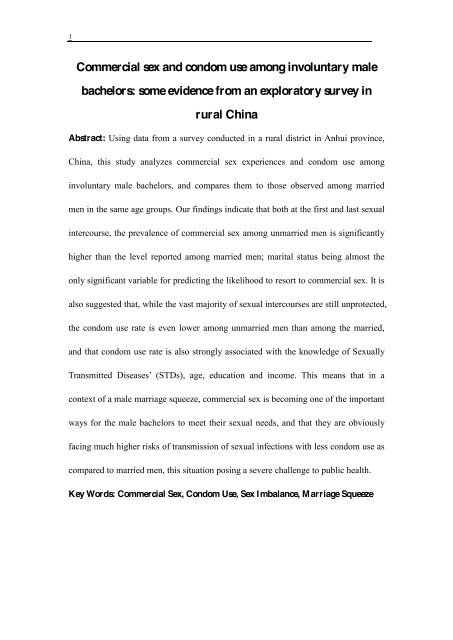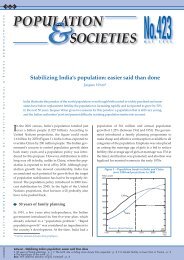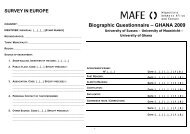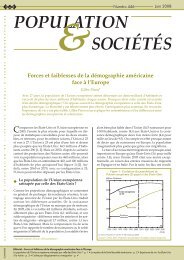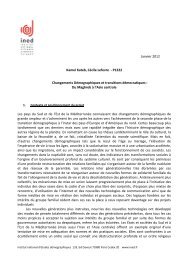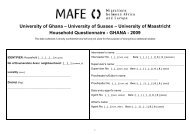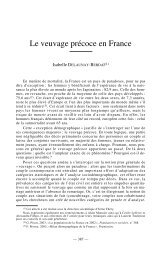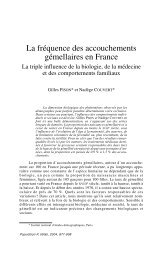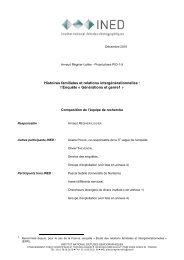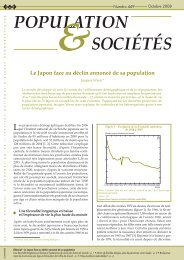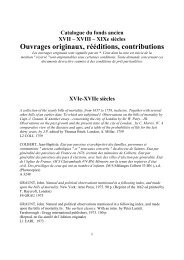Commercial sex and condom use among involuntary male ... - Ined
Commercial sex and condom use among involuntary male ... - Ined
Commercial sex and condom use among involuntary male ... - Ined
You also want an ePaper? Increase the reach of your titles
YUMPU automatically turns print PDFs into web optimized ePapers that Google loves.
1<strong>Commercial</strong> <strong>sex</strong> <strong>and</strong> <strong>condom</strong> <strong>use</strong> <strong>among</strong> <strong>involuntary</strong> <strong>male</strong>bachelors: some evidence from an exploratory survey inrural ChinaAbstract: Using data from a survey conducted in a rural district in Anhui province,China, this study analyzes commercial <strong>sex</strong> experiences <strong>and</strong> <strong>condom</strong> <strong>use</strong> <strong>among</strong><strong>involuntary</strong> <strong>male</strong> bachelors, <strong>and</strong> compares them to those observed <strong>among</strong> marriedmen in the same age groups. Our findings indicate that both at the first <strong>and</strong> last <strong>sex</strong>ualintercourse, the prevalence of commercial <strong>sex</strong> <strong>among</strong> unmarried men is significantlyhigher than the level reported <strong>among</strong> married men; marital status being almost theonly significant variable for predicting the likelihood to resort to commercial <strong>sex</strong>. It isalso suggested that, while the vast majority of <strong>sex</strong>ual intercourses are still unprotected,the <strong>condom</strong> <strong>use</strong> rate is even lower <strong>among</strong> unmarried men than <strong>among</strong> the married,<strong>and</strong> that <strong>condom</strong> <strong>use</strong> rate is also strongly associated with the knowledge of SexuallyTransmitted D (STDs), age, education <strong>and</strong> income. This means that in acontext of a <strong>male</strong> marriage squeeze, commercial <strong>sex</strong> is becoming one of the importantways for the <strong>male</strong> bachelors to meet their <strong>sex</strong>ual needs, <strong>and</strong> that they are obviouslyfacing much higher risks of transmission of <strong>sex</strong>ual infections with less <strong>condom</strong> <strong>use</strong> ascompared to married men, this situation posing a severe challenge to public health.Key Words: <strong>Commercial</strong> Sex, Condom Use, Sex Imbalance, Marriage Squeeze
2BACKGROUNDDue to the traditional son preference combined with the development of technologyfor prenatal <strong>sex</strong> determination, China has been facing an increasingly imbalanced <strong>sex</strong>National Bureau of Statistics2012). Consequently, as these children will grow up, thewith annually at least 10 percent of men in surplus on the marriage market in thecoming decades (Das Gupta & Li, 1999; Guo, 2000; Chen, 2001; Li & Jiang et al.,2006). (so called universal marriage system) (XinqinResearch Institute, 2008). Meanwhile, with the practice of marrying up (so calledgradient marriage model) in which women usually get married with men who havea higher socioeconomic status, men with a lower socioeconomic status can hardly findwomen to get married with (Li et al., 1986). Although this is nothing new in China,the growing shortage of women <strong>and</strong> the increasing cost of marriage for men havemade the problem more acute (Yang et al., 2012a; 2012b; Attané et al. 2013).As explained in a previous research, the characteristics of marriage-squeezedmen are as follows: older than 28 years old, mostly located in remote rural areas, withlow levels of education <strong>and</strong> income, <strong>and</strong> lacking social capitals (Yang et al., 2012a,2012b). Under this social background of universal marriage system <strong>and</strong> gradientmarriage model, being singlehood makes people be facing a great pressure from
3society <strong>and</strong> family (Wei, Jin & Li, 2008; Li & Li, 2008). In Chinese society, Ifpossible, men will get married as could as they can even if they are actually gays. Astudy indicates more than 90% of Chinese men who had same-<strong>sex</strong> <strong>sex</strong>ual orientationwere yet married with a woman in order to hide their real <strong>sex</strong>ual orientation (Y.H. Li,1998; Liu & Lu, 2005). Therefore, we can infer that those unmarried men aged above28 are involuntarily staying bachelorhood <strong>and</strong> could be d Very little is currently known on the <strong>sex</strong>ual practices <strong>among</strong> those <strong>male</strong> marriage-squeezed men who remain unmarried against their will (i.e. the. To try to anticipate the situation that will be faced by agrowing number of <strong>involuntary</strong> Chinese <strong>male</strong> bachelors near future, we haveconducted in 2008 <strong>involuntary</strong> mawhich the present article is based. The purpose of this article is to reveal thecharacteristics of commercial <strong>sex</strong> which is specifically defined here as the <strong>sex</strong>ualintercourse with fe<strong>male</strong> partners (e.g. prostitutes) <strong>and</strong> <strong>condom</strong> <strong>use</strong> <strong>among</strong> these in comparison to that<strong>among</strong> the married men in the same age groups, in order to comprehend theconsequences of <strong>sex</strong> imbalance followed by marriage squeeze at individual level<strong>and</strong> assess potential impact of which on public health.
4LITERATURE REVIEWSexuality of Involuntary Male Bachelors <strong>and</strong> Public HealthI marriage remains in most cases a prerequisite for familyformation <strong>and</strong>, in rural society particularly, the legitimate setting for <strong>sex</strong>ual activity(McMillan 2006; Sun et al., 2009). Under the above-mentioned circumstances, i.e. thereduced availability of fe<strong>male</strong> <strong>sex</strong>ual partners within marriage, the <strong>involuntary</strong>bachelors are likely to look for satisfying alternatives to hetero<strong>sex</strong>ual partnered-<strong>sex</strong>within marriage. For instance, it was reported that the frequency of masturbation <strong>and</strong>the prevalence of same-<strong>sex</strong> <strong>sex</strong>ual behaviour tend to be higher <strong>among</strong> <strong>involuntary</strong><strong>male</strong> bachelors than <strong>among</strong> married men (Yang et al., 2012a, 2012b). Also, it wasindicated that <strong>male</strong> bachelors have higher rates of unprotected <strong>sex</strong> with casualpartners, with increased risks in HIV (Human Immunodeficiency Virus)/AIDS(Acquired Immure Deficiency Syndrome) <strong>and</strong> STDs (Sexual Transmitted Diseases)transmission (Merli & Hertog et al., 2006; Merli & Hertog, 2010). While commercial<strong>sex</strong> which may be adopted to compensate for the absence of hetero<strong>sex</strong>ualpartnered-<strong>sex</strong> within marriage although illegal, is more <strong>and</strong> more widespread incontemporary transitional China (Zuo Q. et al., 2003; Liu B. et al., 2007; Li B. et al.,2008; Wen B. et al., 2012), <strong>condom</strong> <strong>use</strong> during commercial <strong>sex</strong>ual intercourses isbecoming a major concern for public health.Actually, existing research indicates that unprotected commercial <strong>sex</strong> is one ofthe major ways for HIV/AIDS <strong>and</strong> STDs transmission. For instance, a study onsub-Saharan countries suggests that the morbidity due to HIV/AIDS <strong>among</strong> the
5fe<strong>male</strong> <strong>sex</strong>ual workers not using <strong>condom</strong>s is significantly higher than <strong>among</strong> theothers (Morison et al., 2001). Other studies on Asian countries <strong>and</strong> others areas whereHIV infections have developed quickly, indicate similar results (Mills et al., 1998).Therefore, a high prevalence of unprotected commercial <strong>sex</strong> <strong>among</strong> an increasingnumber of <strong>involuntary</strong> <strong>male</strong> bachelors in China is likely to accelerate HIV/AIDS <strong>and</strong>STDs transmission, with a significant impact on public health.On <strong>Commercial</strong> Sex, Condom Use <strong>and</strong> Associated FactorsThe prevalence of commercial <strong>sex</strong> as estimated in the relevant literature varies muchacross regions <strong>and</strong> population groups. Available research indicates that it ranges from2% to 46% in other countries <strong>and</strong> areas including United States, Thail<strong>and</strong>, Africa <strong>and</strong>Latin America, <strong>and</strong> from 4% to 32% in urban China. It was also indicated that factorssuch as knowledge of HIV/AIDS <strong>and</strong> STDs, attitudes, age, marital status, livingarrangements, income <strong>and</strong> educational levels are correlated with the likelihood toresort to commercial <strong>sex</strong> (Celentano & Nelson, 1993; Parrado & Flippen, et al., 2004;W.D. Cai et al., 2006; Carael & Slaymaker, et al., 2006; Wang & Li et al., 2007;Garenne, 2008; B. Li et al., 2008; B. Wen et al., 2012).Condom <strong>use</strong> rate <strong>among</strong> people experiencing commercial <strong>sex</strong> also varies muchacross countries <strong>and</strong> regions, but these variations depend partly on the legal status ofprostitution. In Nevada where prostitution is legal, for instance, <strong>sex</strong> workerssystematically <strong>use</strong> <strong>condom</strong> as it is a legal prescription. But in Zimbabwe, whereprostitution is illegal, only 44% of <strong>male</strong> clients <strong>and</strong> 45% of <strong>sex</strong> workers report using<strong>condom</strong> when having commercial <strong>sex</strong> (Wilson et al., 1989; Albert & Warner, et al.,
61995). Relevant literature indicates that the <strong>condom</strong> <strong>use</strong> rate when having commercial<strong>sex</strong> is even lower in China, ranging from 7.5% to 36% (Liu B., 2007; Li B. et al.,2008; Wen B. et al., 2012). As for the resort to commercial <strong>sex</strong> itself, <strong>condom</strong> <strong>use</strong>when experiencing commercial <strong>sex</strong> is also correlated with various factors includingknowledge of HIV/AIDS <strong>and</strong> STDs, <strong>and</strong> income <strong>and</strong> educational levels (Morris &Pramualratana, et al., 1995; Ford & Wirawan, et al., 1996; Zuo Q. et al., 2003; Lau &Tang, et al., 2003; Wen B. et al., 2012; Liu B. et al., 2007).STUDY DESIGNSurvey <strong>and</strong> DataThe daJC district in this study) of CH city in Anhui province in 2008. This county wasselected for two major reasons: firstly beca<strong>use</strong>, due to the traditional patriarchalsystem, Confucian culture <strong>and</strong> son preference are still very prevalent in this area, <strong>sex</strong>ratio at birth is very imbalanced. Secondly, beca<strong>use</strong> the county is representative ofrural social <strong>and</strong> demographic situation (Attané et al. 2013). As 28 year-old is an important threshold for rural men as beyond it, their chanceto get married is apparently less than younger men(Yang et al., 2012a, 2012b), thesamples in this survey are defined as the rural men aged above 28. The surveysample was selected r<strong>and</strong>omly from the family planning administration registers inseveral villages attached administratively to the JC County. The county was dividedinto three zones, in which six townships or villages were selected, two in each zone.
7Four administrative villages were then r<strong>and</strong>omly selected in each of these townshipsor villages, i.e. a total of 24 villages. Finally, 15 single men were drawn in eachvillage in order to obtain a total of 360 single men aged 28 years or above wereselected initially. Then, as the survey was purpose-designed to study thecharacteristics of single men, so they were intentionally overrepresented in the sample:a ratio of 3:2 was applied to select the sample of married from that of singles. In total,665 men were approached to complete the questionnaire. 38 of these withdrew duringthe process (a dropout rate of 5.7%). Six other questionnaires (0.9%) were withdrawnfrom the survey beca<strong>use</strong> they had been filled too quickly (in less than 20 minutes),which left a total of 621 usable questionnaires (93.4% of the initial sample), of whom44.6% (277) are married <strong>and</strong> 55.4% (344) are single.To guarantee anonymity to respondents <strong>and</strong> allow them to feel free in theirresponses, the CAPI (Computer-assisted personal interviewing) method was <strong>use</strong>d.However, an interviewer was present to give technical assistance to the respondentwhen necessary, but sat in front of him so that he could not see the computer screen.Before starting the process, an interviewer read to each respondent the regulationsconcerning privacy protection, <strong>and</strong> informed on the possibility to withdraw at anytime. In cases where the respondent was illiterate (38 cases) or had a low educationallevel, with the consent of those illiterate respondents, the interviewer read thequestions, explained how to answer <strong>and</strong> helped them complete the survey.MeasurementsIn most existing research, commercial <strong>sex</strong> <strong>and</strong> <strong>condom</strong> <strong>use</strong> are measured by
8calculating the behaviour frequency within a time frame (e.g. the 12 months precedingthe survey), <strong>and</strong> only few of them adopt the likelihood at the first or the last <strong>sex</strong>ualintercourses as a measurement criteria (Carael & Slaymaker, et al., 2006; Parrado &Flippen, et al., 2004; Garenne, 2008). Considering that the <strong>involuntary</strong> <strong>male</strong> bachelorssurveyed have a much lesser access to <strong>sex</strong>ual activity than the married (Attané et al.2013; Li et al. 2010), so the time frame criterion is not fully satisfying. On thecontrary, the first <strong>sex</strong>ual intercourse, which occurs only once in lifetime, <strong>and</strong> the last<strong>sex</strong>ual intercourse, which is the most recent one, are well likely to be reminded by amajority of men (Wellings et al., 2001). In addition, questions about risky <strong>sex</strong>ualbehaviour within a given partnered-<strong>sex</strong> intercourse (i.e. the first <strong>and</strong> the most recentones) are key variables for modelling population patterns of HIV/AIDS <strong>and</strong> STDstransmission (Anderson, Wilson, Doll, Jones & Barker, et al. 1999; Darroch, L<strong>and</strong>ry& Oslak,et al. 1999; Calazans, Araujo & Venturi et al., 2005). Therefore, four keyvariables, which have also proved to be reliable <strong>and</strong> valid in a pilot survey 1 , weredesigned in the present study: <strong>Commercial</strong> <strong>sex</strong> <strong>Commercial</strong> <strong>sex</strong> at the last <strong>sex</strong>ual in Condom <strong>use</strong> at the first <strong>sex</strong>ual <strong>and</strong> Condom <strong>use</strong> at the last <strong>sex</strong> measured by twoquestions including two categories each.As suggested in existing research, attitude regarding <strong>sex</strong>uality should be1 The Institute for Population <strong>and</strong> Development Studies, Xian Jiaotong University conducted apilot survey in YC district, LH city of Henan Province in 2007. This survey finally got data fromin-depth interviews with 22 <strong>involuntary</strong> <strong>male</strong> bachelors, 12 members of these bachelorsy, 3group discussions with community administrators <strong>and</strong> villagers <strong>and</strong> 119 valid questionnaires ofbachelors.
9measured by using categorical variables (Kerstin, Michael & Peter, 2003; Garenne,2008). Therefore, in the present study, the ordinal variable on attitude towardcommercial <strong>sex</strong> is measured by using a five-point item ranging from 1=totallyunacceptable to 5=totally acceptable. Knowledge on HIV/AIDS <strong>and</strong> STDs ismeasured with scores obtained from the relevant questions inspired from existingresearch <strong>and</strong> have proved to be valid <strong>and</strong> reliable (Wen B. et al., 2012; Zuo Q. et al.,2003). for HIV/AIDS scale is 0.75, 0.78 for STDsscale. The higher the scores, the better the level of knowledge about HIV/AIDS <strong>and</strong>STDs.Beside, the variables describing socio-economic <strong>and</strong> individual characteristicssuch as Marital s <strong>and</strong> Age are included in the model, <strong>and</strong> are designed toreflect the characteristics of the target group. Considering the relationship between Marital status d by using the -eight years old is consideredas a threshold age for <strong>male</strong> marriage, after which chances of marrying aresignificantly reduced (Li <strong>and</strong> Li 2008). The age of 35 year-old is another importantthreshold for rural men, beyond which chances to get married are almost zero (Yanget al., 2012a, 2012b). We therefore measured Age by using the two followingcategories: 0=28-35 years old1=older than 35 years old.Other socio-economic variables such as Educational <strong>and</strong> Monthlypersonal income have also proved to be associated with the likelihood to experience
10commercial <strong>sex</strong> <strong>and</strong> <strong>condom</strong> <strong>use</strong> behaviour (Celentano & Nelson, et al., 1993;Parrado & Flippen, et al., 2004; B. Liu et al., 2007; Garenne2008). They weretherefore included in the present study.The basic information on the above-described variables is presented in Table 1.Table 1 here.Analysis StrategiesIn order to describe the characteristics of the resort to commercial <strong>sex</strong> <strong>and</strong><strong>condom</strong> <strong>use</strong> <strong>among</strong> the unmarried men in a context of reduced availability of fe<strong>male</strong><strong>sex</strong>ual partners within marriage, this study has adopted the crosstab <strong>and</strong> independentsample t test methods to compare the prevalence of commercial <strong>sex</strong> at the first <strong>and</strong> thelast <strong>sex</strong>ual intercourses <strong>and</strong> <strong>condom</strong> <strong>use</strong> rate at the first <strong>and</strong> last <strong>sex</strong>ual intercoursesbetween different groups.In order to determine the factors associated with commercial <strong>sex</strong> experiences,this study is based on two groups of models with respectively first commercial <strong>sex</strong> <strong>and</strong> last commercial <strong>sex</strong> <strong>use</strong>d as the dependent variables,attitudes toward commercial <strong>sex</strong>, of HIV/AIDS, knowledge ofSTDs <strong>use</strong>d as the independent variables, marital status age, education <strong>and</strong> <strong>use</strong>d as the control variables.According to the same principle, this study is based on two other groups ofmodels in order to determine the relationship between commercial <strong>sex</strong> experience <strong>and</strong><strong>condom</strong> <strong>use</strong>. In these models, <strong>condom</strong> <strong>use</strong> at the first <strong>sex</strong> <strong>condom</strong> <strong>use</strong> at the last <strong>sex</strong> were <strong>use</strong>d as the independent variables,
11 of HIV/AIDS, knowledge of STDs as the independent variables, <strong>and</strong>commercial <strong>sex</strong> at the first/last <strong>sex</strong> marital status, age,education <strong>and</strong> as the control variables.There are about 24.5% of men in the total sample who reported that they neverhad any <strong>sex</strong>ual intercourse <strong>and</strong> then skipped <strong>and</strong> did not answer the items oncommercial <strong>sex</strong>, meanwhile the non response rates on commercial <strong>sex</strong> items are about15%, therefore the missing data on items about commercial <strong>sex</strong> experience both at thefirst <strong>and</strong> the last <strong>sex</strong>ual intercourses reaches about 40%. However, as explained byHua (2012), the missing data on the binary variable with the percentage below 40% isappropriately treated with pairwise deletion. Therefore, we adopted pairwise deletionmethod to treat the missing data on the items about commercial <strong>sex</strong>.The block regression models described above give a better description of thedifferent roles played by the dependent <strong>and</strong> control variables than a singlemultivariate regression. In this case, the odds ratios of the dependent variables (whencontrol variables are not included) indicate a rough impact of the dependent variableson the independent variable. But when new control variables are included, theadjusted odds ratios of the dependent variables indicate a net impact of the dependentvariables on the independent variable. Such an analytical strategy is commonlyadopted in sociological studies (see for instance: Selim, Fincke, Ren, Lee, Rogers,Miller, Skinner, Linzer & Kazis, 2004).
12RESULTSPrevalence of <strong>Commercial</strong> SexThe prevalence of commercial <strong>sex</strong> experience at the first <strong>and</strong> last <strong>sex</strong>ual intercourses,differences in behaviours between unmarried <strong>and</strong> married men <strong>and</strong> their respectivecharacteristics are presented in table 2. First, the prevalence of commercial <strong>sex</strong>experience at the first <strong>and</strong> last <strong>sex</strong>ual intercourse <strong>among</strong> unmarried men issignificantly higher than the married. Second, knowledge of STDs is significantlyhigher <strong>among</strong> the unmarried men who reported commercial <strong>sex</strong> at their last <strong>sex</strong>ualintercourse than <strong>among</strong> those who did not reported such an experience. In addition,<strong>among</strong> the married men both at their first <strong>and</strong> their last <strong>sex</strong>ual intercourse, the meanvalues of attitudes toward commercial <strong>sex</strong> are higher <strong>among</strong> those who reported acommercial <strong>sex</strong> experience than <strong>among</strong> those who did not,Table 2 hereSignificant differences are also reported between married <strong>and</strong> unmarried men in<strong>condom</strong> <strong>use</strong> rate both at their first <strong>and</strong> last <strong>sex</strong>ual intercourse (table 3), the <strong>condom</strong><strong>use</strong> rate at the first <strong>sex</strong>ual intercourse being significantly lower <strong>among</strong> unmarried menthan <strong>among</strong> the married. However, the unmarried men who <strong>use</strong>d <strong>condom</strong> at their first<strong>sex</strong>ual intercourse obtain significantly higher scores for knowledge of HIV/AIDS <strong>and</strong>STDs than those who did not. In addition, the <strong>condom</strong> <strong>use</strong> rate is significantly higher<strong>among</strong> the younger unmarried men (aged 28-35 years old) than <strong>among</strong> the older (aged35 <strong>and</strong> above); a higher comdom <strong>use</strong> rate is also observed <strong>among</strong> the wealthier ones(with a monthly personal income above 1000 Yuan), as compared to the poorer (with
13a monthly personal income of 1000 Yuan <strong>and</strong> below). It is also suggested that themean scores obtained for knowledge of HIV/AIDS <strong>and</strong> STDs by the unmarried menwho <strong>use</strong>d <strong>condom</strong> at their last <strong>sex</strong>ual intercourse are significantly higher than <strong>among</strong>those who did not <strong>use</strong> <strong>condom</strong>. The <strong>condom</strong> <strong>use</strong> rate is also significantly higher<strong>among</strong> the younger unmarried men (aged 28-35) than <strong>among</strong> the older (aged 35 orolder),Similar relationships are observed <strong>among</strong> married men, with significantly higherscores of knowledge of STDs obtained <strong>among</strong> those who <strong>use</strong>d a <strong>condom</strong> at their first<strong>sex</strong>ual intercourse than <strong>among</strong> the others, <strong>condom</strong> <strong>use</strong> rate being still higher <strong>among</strong>wealthier than the poorer. Married men who reported at least one commercial <strong>sex</strong>experience are also more likely to <strong>use</strong> a <strong>condom</strong> at their last <strong>sex</strong>ual intercourse.Finally, the scores obtained for their knowledge of STDs is significantly higher than<strong>among</strong> those who did not <strong>use</strong> <strong>condom</strong>, <strong>and</strong> the <strong>condom</strong> <strong>use</strong> rate is significantly greater<strong>among</strong> the younger married men (aged 28-35) than <strong>among</strong> those aged 35 or above.Table 3 hereFactors Associated with <strong>Commercial</strong> SexThe regression results of the factors associated with behaviours at the first <strong>and</strong> lastcommercial <strong>sex</strong>ual intercourse are presented in Tables 4.In models A1-A2, attitudes toward commercial <strong>sex</strong>, knowledge ofHIV/AIDS <strong>and</strong> knowledge of STDs are not strongly associated with commercial<strong>sex</strong> experience, no matter if the control variables are included or not. Among thecontrol variables, only marital status is strongly associated with commercial <strong>sex</strong>,
14meaning that unmarried men are more likely to engage in commercial <strong>sex</strong> at their first<strong>sex</strong>ual intercourse than the married.In models B1-B2, attitudes toward commercial se, knowledge ofHIV/AIDS, <strong>and</strong> Knowledge of STDs are not strongly associated with commercial<strong>sex</strong>, no matter if the control variables are included or not. Among the control variables,marital status <strong>and</strong> monthly personal income are strongly associated withcommercial <strong>sex</strong> at the last <strong>sex</strong>ual intercourse, meaning that unmarried men are morelikely to engage in commercial <strong>sex</strong> at their last <strong>sex</strong>ual intercourse than the married,<strong>and</strong> that the men with a monthly personal income higher than 1000 Yuan are morelikely to engage in commercial <strong>sex</strong> at their last <strong>sex</strong>ual intercourse than those withmonthly personal income 1000 Yuan <strong>and</strong> below.When the independent <strong>and</strong> control variables are integrated step by step into theregression models, the value of Cox & Snell R 2 <strong>and</strong> Nagelkerke R 2 become higher,indicating an increase in the explanatory power of the models.Table 4 hereRelationship between <strong>Commercial</strong> Sex <strong>and</strong> Condom UseThe factors associated with <strong>condom</strong> <strong>use</strong> at the first <strong>and</strong> last <strong>sex</strong>ual intercourse arepresented in Table 5.In models C1-C2, knowledge of STDs is strongly associated with <strong>condom</strong> <strong>use</strong>at the first <strong>sex</strong>knowledge of HIV/AIDS is not, no matter if thecontrol variables are included or not, meaning that men with higher scores forknowledge of STDs are more likely to <strong>use</strong> <strong>condom</strong> at their first <strong>sex</strong>ual intercourse.
15Regarding the influence of the control variables, marital status, age <strong>and</strong> monthlypersonal income are indicated to be strongly associated with <strong>condom</strong> <strong>use</strong>, meaningthat unmarried men are more likely than the married to <strong>use</strong> <strong>condom</strong> at their first<strong>sex</strong>ual intercourse; the younger men (aged 28-35) are more likely to <strong>use</strong> <strong>condom</strong> attheir first <strong>sex</strong>ual intercourse than the older (aged 35 or older), as well as the wealthierones (with a monthly personal income higher than 1000 Yuan), as compared to thepoorer ones; however, has no significant impact on <strong>condom</strong> <strong>use</strong>.In models D1-D2, the knowledge of HIV/AIDS has no significantimpact on <strong>condom</strong> <strong>use</strong>, while e of STDs is strongly associated with it, nomatter if the control variables included or not, meaning that men with higher scoresfor knowledge of STDs are more likely to <strong>use</strong> <strong>condom</strong> at their last <strong>sex</strong>ual intercourse.When the control variables are included in the model, the impact of knowledge ofSTDs becomes non-significant, while marital status <strong>and</strong> age are stronglyassociated with <strong>condom</strong> <strong>use</strong>. This means that the impact of knowledge of STDs marital status <strong>and</strong> age, with unmarried <strong>and</strong> youngermen being more likely than the married <strong>and</strong> the older to <strong>use</strong> <strong>condom</strong> at their last<strong>sex</strong>ual intercourse.When the independent <strong>and</strong> control variables are integrated step by step into theregression models, the value of Cox & Snell R2 <strong>and</strong> Nagelkerke R2 becomes higher,indicating an increase in the explanatory power of the models.Table 5 here
16DISCUSSIONS AND CONCLUSIONSMarriage Squeeze <strong>and</strong> the Prevalence of <strong>Commercial</strong> SexThe above analyses indicate that unmarried men report a prevalence of commercial<strong>sex</strong> experience which is significantly higher than that of the married, both at their first<strong>and</strong> last <strong>sex</strong>ual intercourse (with percentages of 10.4% <strong>and</strong> 1.4%, 13.3% <strong>and</strong> 1.9%respectively). Overall, our results are rather consistent with those from other existingresearch conducted in China (ranging from 4-10%) (W.D., Cai et al., 2006; Wang &Li et al., 2007; B. Li et al., 2008; B. Wen et al., 2012). They are not completelycomparable however, as the men surveyed here do not belong to strictly similarsocio-economic groups (most of the available studies for China focus on urbanmigrants, while the present survey targeted only rural men). It is noteworthy howeverthat variations in the likelihood to resort to commercial <strong>sex</strong> across different groupshave been evidenced by other existing studies focusing on other countries in the world(Parrado & Flippen, et al., 2004; Carael & Slaymaker, et al., 2006; Garenne, 2008), assuggested above in the literature review.The results from our regression analysis indicate that marital status is almost theonly significant variable for predicting the experience of commercial <strong>sex</strong> both at thefirst <strong>and</strong> last <strong>sex</strong>ual intercourse (actually, the explanatory power of the models isgreatly improved when marital status is included, as shown above). This means that ina context of <strong>male</strong> marriage squeeze, which is translating into a reduced availability offe<strong>male</strong> <strong>sex</strong>ual partners within marriage, commercial <strong>sex</strong> is suggested to be one of theimportant ways for the <strong>involuntary</strong> bachelors to meet their <strong>sex</strong>ual needs (Attané et al.
172013). s likelihood to resort to commercial <strong>sex</strong> is notuniform <strong>and</strong> depends mainly on their income level: the monthly personal income isactually a strong determinant of the likelihood of experiencing commercial <strong>sex</strong>, thehigher it is, the higher such a likelihood this result being consistent with findingsfrom other existing research (Celentano & Nelson, 1993Parrado & Flippen, et al.,2004; B. Liu et al., 2007).There is a conclusion obtained from above analyses that in the future, an increasein the prevalence of commercial <strong>sex</strong> could go in parallel with the increasing shortageof women in the marriage market, resort to commercial <strong>sex</strong> acting actually as acompensation practice. Such a trend could however have various undesirable effectsboth on the preservation of human rights <strong>and</strong> the fight against human trafficking onthe side of the <strong>sex</strong>-workers, <strong>and</strong> also on public health.<strong>Commercial</strong> Sex, Condom Use <strong>and</strong> Public HealthActually, at their first <strong>and</strong> last <strong>sex</strong>ual intercourse, unmarried <strong>and</strong> married men reported<strong>condom</strong> <strong>use</strong> rate below 20%, which is lower than levels observed in other existingresearch (Wilson & Chiroro, et al., 1989; B. Liu et al., 2007; B. Li et al., 2008; B.Wen et al., 2012). The <strong>condom</strong> <strong>use</strong> rate is even lower <strong>among</strong> the unmarried men attheir first <strong>sex</strong>ual intercourse, at only 7.8%, half the level observed <strong>among</strong> the married:13.4%. The gap persists at the last <strong>sex</strong>ual intercourse, but is narrower: 12.8% <strong>and</strong>16.2% respectively, suggesting that <strong>involuntary</strong> <strong>male</strong> bachelors are facing higher riskswhen having <strong>sex</strong>. That being said, this situation may pose various challenges in termsof public health, <strong>and</strong> especially in terms of HIV/AIDS <strong>and</strong> STDs transmission, as the
18vast majority of commercial <strong>sex</strong> intercourses experienced by the <strong>involuntary</strong> <strong>male</strong>bachelors are still unprotected (see Table 3 above), <strong>and</strong> with the lower levels ofknowledge of HIV/AIDS <strong>and</strong> STDs.Our regression analysis also indicates that <strong>condom</strong> <strong>use</strong> is strongly associatedwith knowledge of STDs, in particular <strong>among</strong> unmarried men. However, given thegreat difference in knowledge of STDs between unmarried <strong>and</strong> married men, themarital status has an adjusted impact on the relationship between knowledge ofSTDs <strong>and</strong> <strong>condom</strong> <strong>use</strong>. Although the descriptive analysis indicates that theknowledge of STDs has a more sensitive impact on <strong>condom</strong> <strong>use</strong> <strong>among</strong> unmarriedmen, those with higher scores of knowledge of STDs are therefore more likely to <strong>use</strong><strong>condom</strong>, <strong>and</strong> this is even more apparent at their last <strong>sex</strong>ual intercourse.Our descriptive analysis indicates that the married men who reported commercial<strong>sex</strong> experience are more likely to <strong>use</strong> <strong>condom</strong> both at their first <strong>and</strong> last <strong>sex</strong>ualintercourse than those who did not reported commercial <strong>sex</strong> but such a relationshipdoes not exist for unmarried men. This difference can be explained by the fact thatmarried men, who are supposed to have a regular <strong>sex</strong>ual partner (namely their spo<strong>use</strong>)are eager to protect her from HIV/AIDS <strong>and</strong> STDs transmission a similarphenomena is also evidenced by other existing research (Vanwesenbeeck, De Graaf &Van Zessen, 1993 ).Both descriptive <strong>and</strong> regression analyses indicate that the younger men <strong>and</strong> thosewith a higher educational level (who are expected to have a higher level of knowledgeof HIV/AIDS <strong>and</strong> STDs) are more likely to <strong>use</strong> <strong>condom</strong>, which is consistent with
19situations observed elsewhere (Morris & Pramualratana, et al., 1995; B. Liu et al.,2007). It is noteworthy however that <strong>condom</strong> <strong>use</strong> is strongly dependent on incomelevel, the men with a higher monthly income being more likely to <strong>use</strong> <strong>condom</strong> thisbeing also evidenced in the latter regression analysis <strong>and</strong> again consistent withfindings from other existing research (Morris & Pramualratana, et al., 1995; B. Liu etal., 2007). Actually, the comparatively high cost of one box of <strong>condom</strong>s (about 15-30Yuan) might actually be a burden to many rural men with poor socio-economicresources, impeding <strong>condom</strong> <strong>use</strong>. This is an important issue to be considered forThere is another conclusion drawn from above analyses: In comparison to thehigher prevalence of commercial <strong>sex</strong>, the <strong>condom</strong> <strong>use</strong> rate <strong>among</strong> unmarried men isrelatively lower, which lead to a high risk in commercial <strong>sex</strong> behaviours of<strong>involuntary</strong> <strong>male</strong> bachelors, may pose potential risks on public health, especially onHIV/AIDS <strong>and</strong> STDs transmission; <strong>and</strong> the <strong>condom</strong> <strong>use</strong> rate <strong>among</strong> forced <strong>male</strong>bachelors is strongly associated with their knowledge of STDs, age, education <strong>and</strong>monthly income.LIMITATIONS AND FUTURE WORKA first limitation of this study is about the sample <strong>and</strong> data. Beca<strong>use</strong> the issuesaddressed concern personal privacy, the number of missing data is relatively high,although the CAPI method was <strong>use</strong>d. E.g. the missing data on items of commercial<strong>sex</strong> experience both at the first <strong>and</strong> the last <strong>sex</strong>ual intercourse is about 40%(considering the skip response, the actual missing data is about 15%), which might
20influence the stability of the results.A second limitation is about the survey itself, as it was not designed to addressspecifically the issue of commercial <strong>sex</strong> <strong>among</strong> the <strong>involuntary</strong> <strong>male</strong> bachelors inrural China. Actually, the limited number of questions about commercial <strong>sex</strong> asked inthe questionnaire <strong>and</strong> the limited scope they cover only give quite general informationon behaviours associated with commercial <strong>sex</strong>.A third limitation is about measurements. This present study only considers thefirst <strong>and</strong> the last <strong>sex</strong>ual intercourses for measuring commercial <strong>sex</strong> experiences <strong>and</strong><strong>condom</strong> <strong>use</strong>, although most similar existing research commonly adopts the frequencywithin a time frame as the measurement, which makes the results from this presentstudy partly incomparable.A future study should be to conduct a survey <strong>among</strong> the rural-urban migrants ona much bigger sample, as well as to conduct in-depth interviews <strong>among</strong> <strong>involuntary</strong><strong>male</strong> bachelors who reported commercial <strong>sex</strong> experience.
21ReferencesAlbert, A. E., D. L. Warner, et al. (1995). "Condom <strong>use</strong> <strong>among</strong> fe<strong>male</strong> commercial <strong>sex</strong>workers in Nevada's legal brothels." American Journal of Public Health 85(11): 1514-1520.Anderson, JE. Wilson, R. Doll, L., Jones T. S & Barker P. (1999). Condom Use <strong>and</strong> HIVRisk Behaviors <strong>among</strong> U.S. Adults: Data from a National Survey, Family PlanningPerspectives 31(1):24-28Ann O, William WD. (1998). Social cultural <strong>and</strong> political aspects, AIDS, 12 (supplA) :189 - 190. Dordrecht: Springer [forthcoming].Attané I., Zhang Q.L., Li S.Z. & Yang X.Y. (2013) men's<strong>sex</strong>uality in a context of fe<strong>male</strong> shortage: some evidence from an exploratory survey in ruralCai W.D., Tan G.J. & Luo X.R. (2006). A survey on knowledge <strong>and</strong> behaviors of AIDS<strong>among</strong> migrants in Shenzhen City, Journal of Public Health <strong>and</strong> Preventive Medicine (inChinese), 17(6):103-104Calazans, G.; Araujo, T.W.; Venturi, G.; França, I.J. (2005). Factors associated with<strong>condom</strong> <strong>use</strong> <strong>among</strong> youth aged 15-24 years in Brazil in 2003, AIDS, 19 (p):42-50Carael, M., E. Slaymaker, et al. (2006). Clients of <strong>sex</strong> workers in different regions of theworld: hard to count. Sexually Transmitted Infections, 82(3): 26-33.Celentano, D. D., K. E. Nelson, et al. (1993). Behavioral <strong>and</strong> sociodemographic risks forfrequent visits to commercial <strong>sex</strong> workers <strong>among</strong> northern Thai men. AIDS (London, Engl<strong>and</strong>)
227(12): 1647.Chen, Y.H.& Ullrich, M. (2001). Chinese <strong>male</strong> overpopulation-scale, structure, influencefactors <strong>and</strong> development trends analysis, Marketing <strong>and</strong> Population Analysis (in Chinese),3:1-11.Darroch J.E., L<strong>and</strong>ry D.J.& Oslak S. (1999). Age Differences Between Sexual Partnersin the United States, Family Planning Perspectives 31(4):160-167Das Gupta, M. & Li, S. Gender bias in China, South Korea <strong>and</strong> India 1920~1990: Theeffects of war, famine, <strong>and</strong> fertility decline[J], Development <strong>and</strong> Change 1999, 30(3),pp:619~652.Ford, K., D. N. Wirawan, et al. (1996). "Behavioral interventions for reduction of<strong>sex</strong>ually transmitted disease/HIV transmission <strong>among</strong> fe<strong>male</strong> commercial <strong>sex</strong> workers <strong>and</strong>clients in Bali, Indonesia." AIDS, 10(2):213-222Garenne, P. M. L. a. M. "Clients of <strong>Commercial</strong> Sex Workers in Zambia: Prevalence,Frequency, <strong>and</strong> Risk Factors." (The Open Demography Journal, 2008, 1, 1-10).Guo, Z.G., Deng, G.S (2000). Study on marriage squeeze in China, Marketing <strong>and</strong>Population Analysis (in Chinese), 3: 1-16.Hua L.L. Simulated Comparison of Different Treat Methods on Missing Data. A Thesissubmitted to Zhengzhou University for Master Degree (in Chinese), 2012Kerstin E. E. S., Michael P.C. & Peter A.V. (2003). Methodological Challenges inResearch on Sexual Risk Behavior: I. Item Content, Scaling, <strong>and</strong> Data Analytical Options,Annual Behavioral Medicine, 26(2): 76103Lau, J. T. F., A. S. Y. Tang, et al. (2003). "The relationship between <strong>condom</strong> <strong>use</strong>, <strong>sex</strong>ually
23transmitted diseases, <strong>and</strong> location of commercial <strong>sex</strong> transaction <strong>among</strong> <strong>male</strong> Hong Kongclients." Aids 17(1): 105.Li Shuzhuo, Zhang Qunlin, Yang Xueyan <strong>and</strong> Attané I. (2010), Male Singlehood,Poverty <strong>and</strong> Sexuality in Rural China: An Exploratory Survey, Population-E, 65(4),679-694Li B., Wang Y., Zhang F., Gao B., Yong L.Z. & Wei L.Q. (2008). A Study on extramarital<strong>sex</strong>ual intercourse <strong>and</strong> <strong>condom</strong> <strong>use</strong> related factors <strong>among</strong> floating population, Chinese Journalof Public Health (in Chinese), 24(7): 791-792Li Z. & Wei S.Z.(1986). Gradient marriage problem, The Contemporary Youth Studies(in Chinese) , (9):21-28Li, S.Z. Jiang, Q.B. & Feldman, W. M. (2006). Gender preference <strong>and</strong> socialdevelopment.(in Chinese), Beijing: China Social Sciences Literature Press.Li, S. Z., & Li, Y. (2008). The pressures <strong>and</strong> strategies of <strong>male</strong> bachelors in rural China:An exploratory study in YC of Henan Province. Youth Study, 11, 15-26. (In Chinese)Li, Y.H. (1998). The subculture of same-<strong>sex</strong> <strong>sex</strong>uality, Beijing: China Today Press (InChinese).Liu B., Lv Y.P., Wan L.S. & Ren X.L. (2007). Analysis on influential factors ofextramarital, commercial <strong>sex</strong>ual behaviors <strong>and</strong> <strong>condom</strong> <strong>use</strong> of STD patients in JiangxiProvince, Contemporary Preventive Medicine (in Chinese), 34(14): 2606-2608Liu, D.L. & Lu, L.G. (2005). The Study on Chinese Same-<strong>sex</strong> <strong>sex</strong>uality (in Chinese),Beijing: Chinese Society Press.McMillan, J, Sex, Science <strong>and</strong> Morality in China (New York: Routledge, 2006), 191 p.
24Merli, M. Giovanna & Hertog, Sara, Masculine <strong>sex</strong> ratios, population age structure <strong>and</strong>the potential spread of HIV in China. Demography Research, 2010 (22):63-94Merli, M.G., Hertog, S., Wang, B., <strong>and</strong> Li, J. (2006). Modeling the spread of HIV/AIDSin China: The role of <strong>sex</strong>ual transmission. Population Studies 60(1): 1-22.Mills S, Saidel T, Bennett A , et al . (1998). HIV risk behavioral surveillance: amethodology for monitoring behavioral trends, AIDS, 12 :153 - 159.Morison, L., H. A. Weiss, et al. (2001). "<strong>Commercial</strong> <strong>sex</strong> <strong>and</strong> the spread of HIV in fourcities in sub-Saharan Africa." AIDS, 15(4): 61-69Morris, M., A. Pramualratana, et al. (1995). "The relational determinants of <strong>condom</strong> <strong>use</strong>with commercial <strong>sex</strong> partners in Thail<strong>and</strong>." AIDS, 9(5):507-515National Bureau of Statistics of China (2011). The main data for the sixth nationalpopulation census, http://www.stats.gov.cn/zgrkpc/dlc/yw/t20110428_402722384.htmParrado, E. A., C. A. Flippen, et al. (2004). "Use of commercial <strong>sex</strong> workers <strong>among</strong>Hispanic migrants in North Carolina: implications for the spread of HIV." Perspectives onSexual <strong>and</strong> Reproductive Health 36(4): 150-156.Vanwesenbeeck I, De Graaf R, Van Zessen G, Straver CJ, Visser JH. Protection styles of Journal ofSex Educcation <strong>and</strong> Therapy. 1993, 19(2):79-92.Wang, B., X. Li, et al. (2007). "HIV-related risk behaviors <strong>and</strong> history of <strong>sex</strong>uallytransmitted diseases <strong>among</strong> <strong>male</strong> migrants who patronize commercial <strong>sex</strong> in China." SexuallyTransmitted Diseases 34(1): 1.Wei Y., Jin X.Y. & Li S.Z. (2008) Stress <strong>and</strong> Coping Strategies in Families <strong>among</strong>
25Forced Unmarried Men: Evidence from YC County in Rural Henan China, Population <strong>and</strong>Development, 5:2-13.Wellings K, Nanchahal K, Macdowall W, McManus S, Erens B, Mercer CH, JohnsonAM, Copas AJ, Korovessis C & Fenton KA, Field J.(2001).Sexual behavior in Britain: earlyhetero<strong>sex</strong>ual experience. Lancet, 358(9296):1843-50.Wen B., Li Y.Y., Zhou Y., Wu J.Q & Zhao R. (2012). <strong>Commercial</strong> <strong>sex</strong>ual behavior<strong>among</strong> migrants in Shenzhen city, Chinese Journal of Public Health (in Chinsese), 28 (3):391-392Wilson, D., P. Chiroro, et al. (1989). "Sex worker, client <strong>sex</strong> behaviour <strong>and</strong> <strong>condom</strong> <strong>use</strong>in Harare, Zimbabwe." AIDS care 1(3): 269-280Xinqin Research Institute. (2008). The Chinese awareness of marriage,http://report.searchina.net.cn/art/report342.htm [2008-10-20/2011/07/05]Yang XY, Attané I., Li SZ, Zhang QL (2012) Masturbation as a compensation forpartnered-<strong>sex</strong> <strong>among</strong> enforced <strong>male</strong> bachelors in rural China findings from a surveyconducted in a context of a deficit of fe<strong>male</strong>s. Journal of Men's Health, 9(4) 220-229.Yang XY, Attané, I, Li SZ & Zhang QL, (2012a) On Same-<strong>sex</strong> Sexual Behaviors AmongMale Bachelors in Rural China: Evidence From a Fe<strong>male</strong> Shortage Context, American-119Zuo Q., Shan G.L., He B., Zhang, K.L., Liu M.& Liu D.H. (2003) Analysis on theCorrelation between Men' <strong>Commercial</strong> Sex Behavior Patterns <strong>and</strong> Their Personality., HealthPsychology Journal (in Chinese), 11(5 ): 328-330
26Table 1 Basic information of all VariablesVariables<strong>Commercial</strong> <strong>sex</strong> at thefirst <strong>sex</strong>ual intercourse??Condom <strong>use</strong> at the first<strong>sex</strong>ual intercourse?<strong>Commercial</strong> <strong>sex</strong> at thelast <strong>sex</strong>ual intercourse?Condom <strong>use</strong> at the last<strong>sex</strong>ual intercourseAttitudescommercial <strong>sex</strong>KnowledgeHIV/AIDStowardofDescriptionNoYesNoYesNoYesNoYesFive-point item ranging from totally to totally acceptableFrequency (Ratio)/Mean (S.D.)366 (95.6%174.4%55789.7%6410.3%35394.6%205.4%53285.7%8914.3%Min/Max0/10/10/10/13.891.06 1/5Five items 3.131.10 1/5Knowledge of STDs Three items 2.560.78 1/3Marital StatusUnmarried 344(55.4%)Married 277(44.6%)0/1Age28-35 23137.2%Older than 3539062.8%0/1EducationPrimary school <strong>and</strong> under 21234.1%High school <strong>and</strong> above 40965.9%0/1Monthly personal 1000 Yuan <strong>and</strong> below 39062.8%incomeHigher than 1000 Yuan 23137.2%0/1
27Table 2 Comparison of commercial <strong>sex</strong> experience between unmarried <strong>and</strong> married men<strong>Commercial</strong> <strong>sex</strong> at the first <strong>sex</strong>ual intercourse? Unmarried (Frequency +Ratio/ Mean+S.D.) Married (Frequency +Ratio/ Mean+S.D.)No Yes No Yes11289.6% 1310.4% 25498.4% 41.6%Chi 2 (Unmarried <strong>and</strong> married)Chi 2 =15.55***p=0.000Attitudes toward commercial <strong>sex</strong> 3.961.07 4.08(1.04) 4.22(0.98) 5.0(0.00)F test (if commercial <strong>sex</strong>) F=0.01p=0.93 F=8.31**p=0.004Knowledge of HIV/AIDS 3.15(1.24) 3.17(1.27) 3.52(0.90) 3.75(0.96)F test (if commercial <strong>sex</strong>) F=0.11P=0.74 F=0.001p=0.98Knowledge of STDs 2.57(0.76) 2.77(0.60) 2.83(0.54) 3.00(0.00)F test (if commercial <strong>sex</strong>) F=3.77*p=0.056 F=1.98p=0.16Age: 28-35 5090.9% 59.1% 9396.9% 33.1%Older than 35 6288.6% 811.4% 16199.4% 10.6%Chi 2 (if commercial <strong>sex</strong>) Chi 2 =0.18p=0.67 Chi 2 =2.48p=0.12Education: Primary school <strong>and</strong> under 5094.3% 35.7% 31100% 00%High school <strong>and</strong> above 6286.1% 1013.9% 22398.2% 41.8%Chi 2 (if commercial <strong>sex</strong>) Chi 2 =2.22p=0.14 Chi 2 =0.56p=0.46Monthly personal income: 1000 Yuan <strong>and</strong> below 6790.5% 79.5% 12198.4% 21.6%Higher than 1000 Yuan 4588.2% 611.8% 13398.5% 21.5%Chi 2 (if commercial <strong>sex</strong>) Chi 2 =0.17p=0.68 Chi 2 =0.01p=0.93To be continued
28Table 2 Comparison of commercial <strong>sex</strong> experience between unmarried <strong>and</strong> married men<strong>Commercial</strong> <strong>sex</strong> at the last <strong>sex</strong>ual intercourse? Unmarried (Frequency +Ratio/ M ean+S.D.) Married (Frequency +Ratio/ Mean+S.D.)No Yes No Yes9886.7% 1513.3% 25598.1% 51.9%Chi 2 (Unmarried <strong>and</strong> married)Chi 2 =20.001***p=0.000Attitudes toward commercial <strong>sex</strong> 6589.0% 811.0% 21399.1% 20.9%F test (if commercial <strong>sex</strong>) 3382.5% 717.5% 4293.3% 36.7%Knowledge of HIV/AIDS Chi 2 =0.96p=0.33 Chi 2 =6.49*p=0.011F test (if commercial <strong>sex</strong>) 3.921.07 4.07(1.22) 4.22(0.99) 4.80(0.45)Knowledge of STDs F=0.00p=0.996 F=3.86+p=0.05F test (if commercial <strong>sex</strong>) 3.13(1.28) 3.43(1.09) 3.51(0.90) 3.60(0.55)Age: 28-35 F=0.55P=0.45 F=1.40p=0.23Older than 35 2.56(0.76) 2.93(0.26) 2.83(0.54) 3.00(0.00)Chi 2 (if commercial <strong>sex</strong>) F=21.92***p=0.000 F=2.47p=0.11Education: Primary school <strong>and</strong> under 4688.5% 611.5% 9496.9% 33.1%High school <strong>and</strong> above 5285.2% 914.8 % 16198.8% 21.2%Chi 2 (if commercial <strong>sex</strong>) Chi 2 =0.25p=0.62 Chi 2 =1.12p=0.29Monthly personal income: 1000 Yuan <strong>and</strong> below 4291.3% 48.7% 2993.5% 26.5%Higher than 1000 Yuan 5684.6% 1173.3% 22698.7% 31.3%Chi 2 (if commercial <strong>sex</strong>) Chi 2 =1.41p=0.24 Chi 2 =3.83+p=0.050Chi 2 (Unmarried <strong>and</strong> married) 5986.8% 913.2% 12297.6% 32.4%Attitudes toward commercial <strong>sex</strong> 3986.7% 613.3% 13398.5% 21.5%F test (if commercial <strong>sex</strong>) Chi 2 =0.00p=0.99 Chi 2 =0.29p=0.59Note: p
29Table 3 Comparison on <strong>condom</strong> <strong>use</strong> between unmarried <strong>and</strong> married menCondom <strong>use</strong> at the first <strong>sex</strong>ual intercourse? Unmarried (Frequency +Ratio/ Mean+S.D.) Married (Frequency +Ratio/ Mean+S.D.)No Yes No Yes31792.2% 277.8% 24086.6% 3713.4%Chi 2 Test (Unmarried <strong>and</strong> Married)Chi 2 =5.027*p=0.025<strong>Commercial</strong> <strong>sex</strong> at the first <strong>sex</strong>ual intercourse: 8979.5% 2320.5% 21999.1% 20.9%NoYes 969.2% 430.8% 3594.6% 25.4%Chi 2 Test (If <strong>use</strong> <strong>condom</strong>) Chi 2 =0.072p=0.40 Chi 2 =4.21*p=0.04Knowledge of HIV/AIDS 2.841.16 30.93 3.440.96 3.470.92F test (if commercial <strong>sex</strong>) F=4.04*p=0.046 F=0.08p=0.78Knowledge of STDs 2.350.87 2.700.61 2.770.62 2.890.39F test (if commercial <strong>sex</strong>) F=22.95***p=0.000 F=6.30*p=0.013Age:11085.3% 1914.7% 8684.3% 1615.7%28-35Older than 35 20796.3% 83.7% 15488.0% 2112.0%Chi 2 (if commercial <strong>sex</strong>) Chi 2 =13.51***p=0.000 Chi 2 =0.75p=0.38Education: Primary school <strong>and</strong> under 16293.6% 116.4% 3692.3% 37.7%High school <strong>and</strong> above 15590.6% 169.4% 20485.7% 3414.3%Chi 2 (if commercial <strong>sex</strong>) Chi 2 =1.07p=0.30 Chi 2 =1.26p=0.26Monthly personal income: 1000 Yuan <strong>and</strong> below 24495.3% 124.7% 12391.8% 118.2%Higher than 1000 Yuan 7383.0% 1517.0% 11781.8% 2618.2%Chi 2 (if commercial <strong>sex</strong>) Chi 2 =13.83***p=0.000 Chi 2 =5.95*p=0.015To be continued
30Table 3 Comparison on <strong>condom</strong> <strong>use</strong> between unmarried <strong>and</strong> married menCondom <strong>use</strong> at the last <strong>sex</strong>ual intercourse? Unmarried (Frequency +Ratio/ Mean+S.D.) Married (Frequency +Ratio/ Mean+S.D.)No Yes No Yes30087.2% 4412.8% 23283.8% 4516.2%Chi 2 Test (Unmarried <strong>and</strong> Married)Chi 2 =1.49p=0.22<strong>Commercial</strong> <strong>sex</strong> at the last <strong>sex</strong>ual intercourse: No 6566.3% 3333.7% 21383.5% 4216.5%Yes 853.3% 746.7% 240.0% 360.0%Chi 2 Test (If <strong>use</strong> <strong>condom</strong>) Chi 2 =0.96p=0.33 Chi 2 =6.49*p=0.011Knowledge of HIV/AIDS 2.771.15 3.340.99 3.410.97 3.630.82F test (if commercial <strong>sex</strong>) t=-2.99**p=0.003 t=-1.37p=0.17Knowledge of STDs 2.320.88 2.770.57 2.760.62 2.910.36F test (if commercial <strong>sex</strong>) F=57.40***p=0.000 F=11.25**p=0.001Age: 28-35 9876.0% 3124.0% 7876.5% 2423.5%Older than 35 20294.0% 136.0% 15488.0% 2112.0%Chi 2 (if commercial <strong>sex</strong>) Chi 2 =23.38***p=0.000 Chi 2 =6.30*p=0.012Education: Primary school <strong>and</strong> under 16193.1% 126.9% 3692.3% 37.7%High school <strong>and</strong> above 13981.3% 3218.7% 19682.4% 4217.6%Chi 2 (if commercial <strong>sex</strong>) Chi 2 =10.69**p=0.001 Chi 2 =2.44p=0.12Monthly personal income: 1000 Yuan <strong>and</strong> below 23893.0% 187.0% 11888.1% 1611.9%Higher than 1000 Yuan 6270.5% 2629.5% 11479.7% 2920.3%Chi 2 (if commercial <strong>sex</strong>) Chi 2 =29.76***p=0.000 Chi 2 =3.53p=0.60Note: p
31Table 4 Factors associated with commercial <strong>sex</strong>Dependent variable: commercial <strong>sex</strong> at the first <strong>sex</strong>ual M odel A1M odel A2intercourse (reference: no)Attitudes toward commercial <strong>sex</strong> 1.10 1.16Knowledge of HIV/AIDS 0.76 0.73Knowledge of STDs 1.57 1.97M arital Status (Reference: unmarried)Married 0.09**Age (Reference: 28-35)Older than 35 1.34Education (Reference: Primary school <strong>and</strong> under)High school <strong>and</strong> above 4.20+M onthly personal income (Reference: 1000 Yuan <strong>and</strong> below)Higher than 1000 Yuan 0.882 Log Likelihood 129.37 110.73Cox & Snell R 2 0.003 0.05Nagelkerke R 2 0.008 0.18Dependent variable: commercial <strong>sex</strong> at the last <strong>sex</strong>ual M odel B1M odel B2intercourse (reference: no)Attitudes toward commercial <strong>sex</strong> 1.02 1.14Knowledge of HIV/AIDS 0.78 0.76Knowledge of STDs 3.65 6.37+M arital Status (Reference: unmarried)Married 0.09***Age (Reference: 28-35)Older than 35 1.34Education (Reference: Primary school <strong>and</strong> under)High school <strong>and</strong> above 1.19M onthly personal income (Reference: 1000 Yuan <strong>and</strong> below)Higher than 1000 Yuan 0.001*2 Log Likelihood 143.85 122.40Cox & Snell R 2 0.009 0.069Nagelkerke R 2 0.027 0.199Note: p
32Table 5 <strong>Commercial</strong> <strong>sex</strong> <strong>and</strong> the <strong>condom</strong> <strong>use</strong>Dependent variable: <strong>condom</strong> <strong>use</strong> at the first <strong>sex</strong>ual intercourse M odel C1Model C2(reference: no)Knowledge of HIV/AIDS 0.87 0.72+Knowledge of STDs 2.04* 1.45<strong>Commercial</strong> <strong>sex</strong> at the first <strong>sex</strong>ual intercourse (Reference: no)Yes 2.07M arital Status (Reference: unmarried)Married 0.58Age (Reference: 28-35)Older than 35 0.54*Education (Reference: Primary school <strong>and</strong> under)High school <strong>and</strong> above 0.79M onthly personal income (Reference: 1000 Yuan <strong>and</strong> below)Higher than 1000 Yuan 2.39*2 Log Likelihood 357.51 286.62Cox & Snell R 2 0.013 0.061Nagelkerke R 2 0.027 0.104Dependent variable: <strong>condom</strong> <strong>use</strong> at the last <strong>sex</strong>ual intercourse Model D1Model D2(reference: no)Knowledge of HIV/AIDS 1.15 0.93Knowledge of STDs 2.12** 1.48<strong>Commercial</strong> <strong>sex</strong> at the first <strong>sex</strong>ual intercourse (Reference: no)Yes 2.16M arital Status (Reference: unmarried)Married 0.33***Age (Reference: 28-35)Older than 35 0.42***Education (Reference: Primary school <strong>and</strong> under)High school <strong>and</strong> above 1.38M onthly personal income (Reference: 1000 Yuan <strong>and</strong> below)Higher than 1000 Yuan 1.69+2 Log Likelihood 454.41 333.61Cox & Snell R 2 0.035 0.11Nagelkerke R 2 0.062 0.17Note: p


